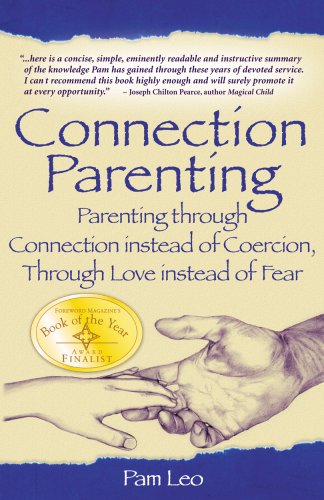Teaching Through Love Instead Of Fear
Can you imagine threatening your partner or good friend by counting “One… two… three…” if he or she did not do what you wanted?
One of the big issues in schools today is “bullying.” Parents and teachers struggle daily with how to stop this behavior. Without realizing it, adults teach bullying behavior to children by modeling it when they use the threat of their physical size or power to make children do things. When I hear a parent counting “One… two” at a young child, I always wonder what the child has been told will happen if the parent gets to three. Is it the threat of a spanking, being yelled at, time out, abandonment (I’m going without you) or the withdrawal of love and approval? Whatever the threat may be, I rarely hear “three.” As intended, the threat of what will happen if the parent gets to three usually compels the child to do whatever it is the parent is telling the child to do. Parents use threats to get children to cooperate because that was what adults so often modeled when we were growing up. Most of us are familiar with the phrase “or else.” We did what we were told out of fear even if we didn’t know what the “or else” would be.
 While counting may appear to be a magic form of discipline, there is no magic in threats. Children know that adults are bigger and more powerful than they are. They comply in self-defense. If the only way we can get children to do what we ask is by intimidating them with our greater physical size and power, how will we get them to do as we ask when we are no longer bigger and stronger? ” Ask the parents of any teenager if counting still works. Not only do threats no longer work, they’ve learned to use the same means to make others do what they want.
While counting may appear to be a magic form of discipline, there is no magic in threats. Children know that adults are bigger and more powerful than they are. They comply in self-defense. If the only way we can get children to do what we ask is by intimidating them with our greater physical size and power, how will we get them to do as we ask when we are no longer bigger and stronger? ” Ask the parents of any teenager if counting still works. Not only do threats no longer work, they’ve learned to use the same means to make others do what they want.
Many parents see a child’s uncooperative behavior as a challenge to their authority. Once we understand that uncooperative behavior is usually caused by a child’s unmet need or an adult’s unrealistic expectation, we don’t have to take the behavior so personally. Parents and children often have different needs. Sometimes our needs or schedules conflict with our children’s needs. Children who are deeply absorbed in play will not want to interrupt their play to go with us to the bank or the store before it closes. When a parent needs to do one thing and a child needs to do something else there is a conflict of needs. This conflict of needs turns into a power struggle when parents use the power of fear instead of the power of love. The bond or connection parents have with their children is their most powerful parenting “tool.” A strong bond is created over time when parents lovingly and consistently meet a child’s early needs. Threats communicate, “What you think, feel, want or need is not important.” Threats undermine the parent-child bond. When we learn to resolve our “conflicts of needs” in ways that show children that their needs and feelings matter, we strengthen the bond and avoid many power struggles.
The most common reason for conflict of needs between parents and children is lack of resources. If parents had more resources we wouldn’t have to bring the child to the bank or the store because there would be someone else to stay with the child. As long as there is lack of resources there will be conflicts of needs. Until we figure out how to bring more resources into our lives we have to find other ways to resolve our conflicts if we are to stop teaching children to be bullies. If we want to teach children to love instead of hate, we must learn to use conflict resolution skills in our daily interactions with children. Just as children learn bullying from what adults model, they can learn conflict resolution and problem solving skills from what we model. When children learn the skills from how we treat them at home they will bring those skills to their relationships at school.
Very young children can learn conflict resolution if we model it. An older sibling can be taught to find another toy to exchange with their younger sibling instead of just snatching their toy back. When two children want the same toy at the same time we can help them “problem solve” a solution. When there is a conflict of needs because the parent wants to do an errand and the child just wants to stay home and play we can say “let’s problem solve to see if we can find a way for us both to get what we need.” Maybe the child could take the toy in the car or perhaps the errand could wait until tomorrow. When the parent is ready to leave the playground and the child wants to stay longer we can suggest a compromise of five more minutes and doing something fun when we get home. Often it’s not that the child doesn’t want to leave as much as it is that she doesn’t want the fun to end. When we teach children that everyone’s needs are important by honoring their needs they learn to honor the needs of others.
There will be times that we won’t have the time or the resources to meet a child’s need. There will be times that even after honoring the child’s need, the child is still unable to cooperate. At those times it is important to communicate that parents have needs too and even though it makes the child unhappy we do have to go now and then allow the child to have his feeling about having to leave. It is never OK to tell a young child that you will leave without them. Threatening a child with abandonment terrifies a child. When a child has a tantrum about leaving it may not be about leaving the playground at all. Leaving may just be the last straw that unleashes the day’s accumulation of little frustrations. The child may just need to cry to empty out the stresses of the day. A child will be able to move forward much more readily when we can say “I know you’re sad and it’s OK to cry” than if we say “Stop that crying or I’ll give you something to cry about!” When the crying is done the child will usually feel better and be more able to cooperate.
When children’s needs are met and nothing is hurting them they are usually delightful to be with. Whenever a child responds negatively to a reasonable request we need to look for the conflicting need. Once we know how our needs are in conflict we can try to problem solve. I have learned to say, “When you behave that way I know something is wrong, because we love each other and people who love each other don’t treat each other this way. Can you tell me what you need or what’s hurting you?” If I can remember to stop and ask that one simple question it changes the whole context of the conflict. That question communicates, ” I love you and what you feel and need matters to me.”
Sometimes there isn’t a way for both people to get what they need. But not getting what we need is much easier to bear if we are treated in a way that allows us to keep our dignity. Counting at a child communicates, “I am bigger and more powerful than you and you’d better do as I say or I’m going to (in some way) hurt you.” When a big kid says to a smaller one, “Do what I say or I’m going to hurt you,” we call it bullying. When an adult communicates the same thing to a child by counting, we call it discipline. When we treat children in ways that take away their dignity we teach them how to take away other’s dignity. If we want kids to stop bullying, we have to stop bullying kids. The power of fear is easy and quick but short-lived. The power of love requires more work and takes longer but children never outgrow its influence.
Photo Shutterstock/Vadim Martynenko


